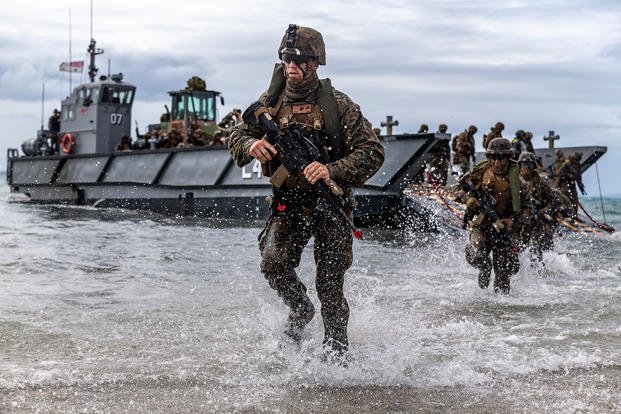The Navy and Marine Corps must join forces to combat threats China poses at sea, a top U.S. general said Wednesday.
The U.S. needs an integrated naval force that is prepared to take on China, Marine Commandant Gen. David Berger said at the annual Surface Navy Association conference. That's going to require the sea services to work a lot more closely than they have over the last 20 years.
"The significant thing that's driven as to where we are right now is a paradigm shift by China in moving to the sea," he said. "We have watched them build and expand a conventional defensive force and kind of yawned for a long time until they went to sea.
"Game-changer," Berger added.
Related: Unmanned Vessels Won't Count as Warships in Next Navy Force Assessment: CNO
China has been building forward-operating bases on man-made islands in the South China Sea. The islands have barracks, runways and hangars.
"New threats are here," Berger said. "We must change."
Here's a look at how the Navy and Marine Corps could adapt to take on China.
Marines on More Decks. Leathernecks aren't going to limit their cruises to amphibious assault ships. Marines could someday deploy on littoral combat ships and next-generation frigates too, Berger said.
"I think [those ships] have roles for Marines," he said. "I would just tell you there's nothing off the table for the Marine Corps and the Navy. There are no red lines, 'we don't get on that ship' or 'that's not for that use.'"
Marines must learn how to complement other platforms, the commandant added.
"Smaller, But Capable." The Navy and Marine Corps are going to need a lot more ships, Berger said, as the sea services look toward distributed operations across the vast Pacific theater.
Fixed bases and large ships would leave sailors and Marines vulnerable, he said, citing "Fleet Tactics and Naval Operations" by Wayne Hughes and Robert Girrier.
That doesn't mean big-deck amphibs will go away completely, Berger said. "But I think we add a lot of small" ships.
"I'm not talking cheap because we don't need cheap," he said. "It's great power competition -- they are good. But we need a distributed maritime force. ... That drives you toward more. Smaller, but capable."
Fit to Fight. The Navy and Marine Corps can no longer expect to operate from a distance when it comes to China.
Crews, he said, must be prepared to switch from deterrence to offense quickly.
"There is an argument to be made by some who feel that two great powers can stand off with long-range precision weapons and hold each other at bay," Berger said. "I am not in that camp. And reality over the last few years should tell you that doesn't work against this adversary because the farther you back away from China, they will move toward you."
Keeping Them Guessing. The Navy and Marine Corps can't send warships out that look the same every time, Berger said.
To "mess up an enemy threat's mind," he said, the Navy and Marine Corps must be unpredictable.
That could mean loading an amphib up with F-35B Joint Strike Fighter jets on one deployment then sending the next ship out full of MV-22 Osprey tiltrotor aircraft, followed by a mix of the two.
"We need to constantly pose this adversary with different looks," the commandant said.
Force-Wide Reviews. The Navy and Marine Corps are both undergoing assessments that could reshape the look of each sea service.
The Navy's force-structure assessment will determine the optimal size of the fleet. Chief of Naval Operations Adm. Michael Gilday said Tuesday that the assessment could be done within weeks and is likely to top the 355-ship fleet the last assessment suggested.
The Navy will also make room to add a fleet of unmanned vessels to that count, Gilday said. The service is working closely with the Marine Corps to determine the best fleet size.
The Marine Corps is looking at its fleet, too, in terms of personnel. Berger called a force-structure review his top priority in his planning guidance, and it could close some military occupational specialties while others ramp up.
In November, Berger said, "The Marine Corps ... will look very radically different than what we have right now."
-- Gina Harkins can be reached at gina.harkins@military.com. Follow her on Twitter @ginaaharkins.
Read more: Force-Wide Review Could Result in a 'Radically Different' Marine Corps













